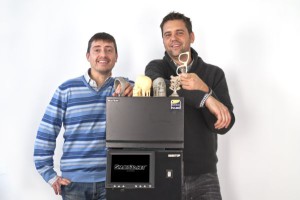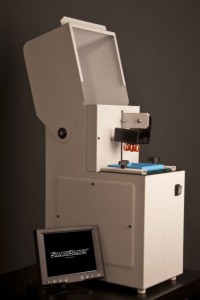Two new professional and fast 3D printers based on the DLP technology. They have been developed by Smart3D.net taking into account the requirements of the jewellery and costume jewellery industry, but due to their rapidity and quality features they are suitable also for mould and die makers.
In a district like Valenza, where more than two thousand goldsmiths and jewellers operate, it could not miss a company able to supply software, products and services to the artisans paying utmost attention to new technologies. Therefore, Andrea Gié and Andrea Dotta, both actor sons of actor fathers because both their families have been operating in the sector for generations, have founded Smart3D.net. Schoolmates, after school both Andreas undertook different roads but both leading towards high technology and especially three-dimensional CAD modelling. Just during a course of Rhino, the powerful free-form 3D modeller by Rhinoceros arrived at its fifth release and widely used also in jewellery, they met again. They were the early 2000s and they did not hesitate to give birth to the current company with the ambitious initial purpose of developing software dedicated to the distribution of diamonds on the surface of jewels, a very burdensome task for jewellers that sometimes must arrange even more than 300 diamonds on a ring. Result brilliantly achieved, it is just worth saying it, and still today the company successfully proposes its software, constantly upgraded, which allows reducing to few hours an activity that took a whole week before. Afterwards, the Valenza company decided to extend its competence ambit to the 3D printing to allow giving physical body to what designed by designers with 3D modellers. In 2011, the two Andreas realized that the prices of the 3D printers marketed at that time were too high for the gold sector. Therefore, they decided to develop in-house 3D printers with the most suitable characteristics for the requirements of that sector. The result? A range now composed by five models with different prices and characteristics. We are analysing the two most interesting novelties of the range, Tucano One and Tucano 2 RP. «Both printers – explains Andrea Gié – are based on the DLP technology and thanks to some patented systems we succeeded in improving the printing speed, one of the best on the market, without affecting their quality». DLP, acronym of Digital Light Processing, is one of the main 3D printing technologies today available on the market. It is based on the use of resins that harden under the light of a projector layer after layer. «We are specialized – adds Gié – in meltable materials suiting sectors that range from jewellery to biomedical. We have developed resins also for extreme uses, which are for instance resistant to maximum temperatures of 120° to manufacture silicone moulds. Or ceramic resins that allow implementing prototypes with excellent mechanical resistances that can be also metallized through galvanic processes» Smart3D is a company with a wide-ranging activity in the 3D printing sector. Not only it has developed its printers and printing materials but it has also implemented the software making them operate and it can be a partner for its customers from the idea to the final object.
Tucano One: fast and professional
Tucano One is a professional printer standing out for its interesting quality/price ratio. Small and compact, it was conceived for designers, small laboratories, the modelling department of a big company. One of its most salient characteristics is certainly speed, deriving from the adoption of the DLP technology and from some particular patented structural solutions: a ring is printed in less than two hours and, in general, it manufactures prototypes at a speed that reaches five centimetres/hour of object eight (15 millimetres/hour at 50 microns). In the 3D printing, as well-known, the sizes of the print base do not influence performances significantly The printing speed naturally varies also according to the used resin. Smart3D supplies various types for this machine, from F3-White for high speeds up to LW-1 for high-definition works. These materials are developed and produced by the research centre of the Valenza company. The work area of Tucano One is 55x35x70 millimetres. The native resolution on X and Y axes is of 50 microns, while on the Z axis is of 2.5 microns. Concerning the layer thickness, the characteristic layers of the 3D printing, we can choose a value included between 10 and 100 microns. «The finishing that it is possible to achieve with this model – explains Andrea Gié – is suitable for the jewellery sector but it can be used also for modelling in big companies. They sometimes have machinery that it is expensive to start and Tucano One can be a fast and precise alternative in several cases.

Tucano 2 RP can print prototypes with max. height of twenty centimetres at high speed, without giving up quality
Tucano 2 RP, big print size
In Tucano 2, 3D printer recently on show at primary sector exhibitions in Vicenza and Paris, respectively dedicated to high jewellery and to costume jewellery, the initials RP stand for “Rapid Prototyping”. Thanks to its features, it goes beyond the requirements of these fields, since, due to its prototyping speed and the print sizes, it can manufacture objects that go from glasses to fashion accessories, to design objects to industrial models. As a matter of fact, its print area, which is the biggest of all those designed and produced by Smart3D.net, is formed by a base of 110×65 millimetres and by a height of a good 200 millimetres. Speed is very interesting, too, because it can reach one centimetre/hour of height when it works at 25-micron resolutions and 5 centimetres/hour with 50- micron layers. The choice of the layer height ranges from 5 to 100 microns, depending on the quality that you want to obtain (obviously, the lower is this value the slower is the printing speed). The mechanical resolution of this model is 0.5 micron. Various resins developed by Smart3D are available for Tucano 2 RP, too, to be chosen according to the result that you want to attain in terms of resolution, speed, mechanical or heat resistance.




